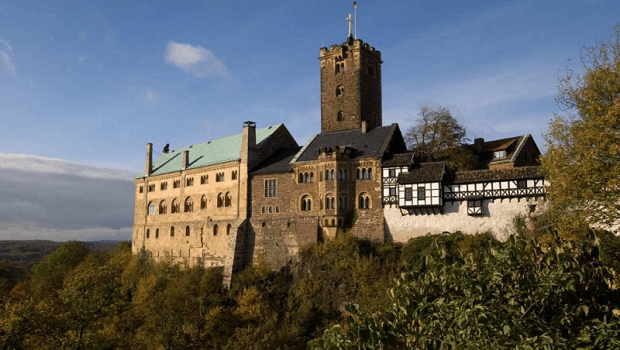
Schloss Wartburg: OF and By the Medieval Era
Schloss Wartburg or the Wartburg Castle dates back to the Middle Ages and is located in the city of Thuringia which is further located in the north-western corner of the forested region of Thuringian.
The location of Schloss Wartburg is fascinating in its own right. It quite literally watches over the city of Eisenach, as an imposing figure. In all its grandiose and the sheer gravity that this castle expresses is unique and sacred at the same time. The Wartburg Castle is historic in every respect and is among the most well preserved Romanesque castles within the German region. The castle further explicates a kind of sensual-ness though its gravitas that can only be experienced by looking at it upfront. Reaching the castle is definitely bound to give you a sense of a fairy tale setting. This is so because to arrive right at the castle one has to pass through a draw bridge.
Schloss Wartburg is almost a thousand years old and it is purely a matter of fascination that how a building can carry the entire history and heritage of an entire nation in every inch of its bricks. The surrounding area of the castle displays impressionable treasure collections that it has managed to preserve over the centuries. Here you can art pieces in addition to tapestries, musical instruments from the medieval era and varieties of silverware. Due to all these reasons the UNESCO world heritage list adopted Schloss Wartburg as a heritage in the year 1999.
Martin Luther, the reformer once survived simply because the castle offered him a refuge. Furthermore, it is within the walls of this building that he translated the bible into the German language and interestingly it only took him just about 11 weeks. Back in the day the castle also featured as an important courtly cultural site. Historical documents have suggested that here some of the most noted medieval singers would partake in musical contests.
All is in the name
The name – ‘Schloss Wartburg’ is considered to have been derived from the German word ‘warte’ which means a watch tower. One fact that surmounts the very existence of the castle is brought forward from its founder. He is known to have said, “Warte, Berg — du sollst mir eine Burg tragen!” Furthermore, this translates in the English language as – Wait, mountain — you shall bear my castle! Here one can see as to how Germans play on the words Berg and Burg which mean mountain and fortress respectively.
Additionally, Louis the Springer who was also otherwise known as Louis the Jumper or Louis the Leaper or Louis of Schauenburg, the count who ruled over Thuringia (1056 to 1123) is known to have had brought clay (soil) from his own territory on top of the hill to form the foundation of the castle which otherwise was not under his rule.
Location
Wartburg Castle is located at a height of 410 metres or 1,350 feet above sea level on a very steep cliff in the southwestern corner of the state of Thuringia, Germany. The hill upon which the castle is located, it is formally an extended section of the Thuringian Forest region. Its imposition is such that it overlooks the city of Mariental that is located in the south eastern side along with the Hörsel that is in the northern side. Furthermore, it is thorough this valley that the historic route to Regia passed through. If you want to reach the Rennsteig and enjoy the beautiful sights along the ridge then you will simply have to head a bit in south of the castle.
History – A bit of dramatic stage
The history of the castle begins in the year 1067 when Louis the Springer or Ludwig der Springer, the count of Schauenburg who was also related to the Counts of Rieneck in Franconia laid the foundation of the castle. The sister castle of the Wartburg Castle is known as the castle at Neuenburg that is located in the town of Freyburg. It was important that the castle be constructed so that the extreme location of the region can further be secured.
Bruno, the Bishop of Merseburg was the first to have documented the first reference of the castle. He recorded the evidences in his De Bello Saxonico or the Saxon War that dates back to the year 1080.
Between the years 1172 and 1211 the Wartburg Castle featured among the most important royal courts that existed at that point in time in the German Reich. The then ruler Hermann I would act as a patron for numerous poets such as Walther von der Vogelweide and Wolfram von Eschenbach. There were writers as well like Albrecht von Halberstadt who had famously translated Ovid. Later on Richard Wagner used this legend in his opera – Tannhäuser.
The impact of the Investiture Controversy
Back in the 11th and the 12th centuries many of the European monarchies were attacked by a series of popes. This event was the most significant conflict that took place between the Church and the state in Medieval Europe. The matter of the issue surrounded the question as to who had the authority pertaining to the appointment of bishops and abbots.
This struggle could only reach the point of conclusion by the year 1122. At this point in time the Henry V, the Holy Roman Emperor and Pope Calixtus II truced by signing the Concordat of Worms or the Pactum Calixtinum on the 23rd of September. The outcome of this agreement was to limit the role played by the emperors in the selection process of the bishops. Moreover, it does seem to appear as though the church was victorious, but the fact of the matter still remains that the Emperor did hold a considerable amount of influence over the Church. Historians have marked this struggle as the first of its kind that leads towards the 1648 Treaty of Westphalia.
For the longest time in history Schloss Wartburg has been an important site of pilgrimage. People from and outside of Germany have been flocking here each year due to the significant position that the castle holds not only in the history of Germany but more importantly in the development of Christianity.
Opening Hours of Schloss Wartburg
- Beginning from March to October: 8:30 a.m. – 8:00 p.m.
- Beginning from November – February: 9:00 a.m. – 5:00 p.m.
The Wartburg is the most famous castle belonging to the noble family of Ludowinger. It is their ancestors such as Ludwig the Bearded who was the father of Louis Springer further belonging to the family of the Counts of Rieneck from Lower Franconia , the viscount of the Archbishop of Mainz who resided here. It is in-fact due to their support that the castle developed to reach its heights back in the Medieval Ages.
The Wartburg Castle has been constructed on a narrow and steep ridge that rises to a height of about 220 meters above the city of Eisenach. The castle originally comprised of four sections, of which only two survive and are well preserved today. Most of the restoration was conducted due to Goethe’s initiative.
When you are in the castle don’t forget to visit the following:
- Section I: This comprises of the entrance of the castle and it is here that the original military buildings are located.
- Bailey: To reach this section one has to cross the drawbridge. It originally was a gated tower in the Middle Ages. This section comprises of curtain walls that belong to the 12th century and its western section is called the Margaret transition.
- The main castle: This section was fortified when Goethe first arrived here and is dominated by the late Romanesque Palas and the Landgraf house.
- The South Section: The southernmost part of the castle exists almost separately because of certain topographical reasons of the Middle Ages. Here you can find the south tower and consisted various important documents pertaining to the legislative history of the castle.
- Gasthof: It was designed much later between 1912 and 1914 by Bodo Ebhardt the Wartburg-Gasthof.
- Concert Hall: It is the most famous concert hall in the Thuringia region and it has ever since been extensively contributing to the cultural development of the region.
Touring details
If you wish to take a guided tour of the castle then you can pay a small fee and get it and people from the Anglophone countries don’t have to worry, guided tours are also conducted in the English language.
When on such a tour keep your eyes open especially for the cell of Martin Luther. It is one impressive chamber and particularly notice the ink stains that are preserved on the walls. As per the local beliefs, Martin Luther threw the ink at the devil right at that spot.
The prices for admission are as follows:
- For adults: 7 Euros
- For Students and children: 4 Euros
Additional Information:
- Schloss Wartburg also houses a full functioning restaurant serving the best of the regional cuisine along with other German delicacies.
- During the winter months you will get a chance to visit the regional Christmas market that features historically significant crafts such as – glassblowing and stonecutting.
- If you want to film your tour then by paying a nominal fee of 5 Euros that can be done. In case if you just want to click photographs then the charges are as low as 1 Euros.
Other than the castle the region also offers numerous options of adventure. You can begin by scaling any of the following mountain peaks:
- Großer Beerberg Schützenberg: 904 metres tall and located in the main crest of Oberhof.
- Greifenberg: 901 metres tall and situated in the main crest in the west of Oberhof.
- Gebrannter Stein: It is 897 metres tall and located in the south of the Rennsteig and north of Zella-Mehlis.
- Donnershauk: It is 894 metres tall and located in the centre section of the main crest.
- Schmalkalder Loibe: 886 metres tall and located in the western section of the main crest.
- Großer Hermannsberg: It is 867 metres tall located in the southwestern flank.
- Ruppberg: This 866 metres tall mountain is situated in the southwest flank.
- Großer Buchenberg: It is nearly 813 metres tall and located in the north of the main crest which is also in the southwestern direction of the Schmalwasser Dam.
- Krämerod: It is 765 metres tall and is located in the main crest, further in the extreme northwestern side of the region.
- Schwarzer Kopf: It is located in the southwest of Zella-Mehlis and is 749 metres tall.
- Siegelberg: It is 734 metres tall and is located in the extreme northeastrn side of the region along with being in the southeast of Luisenthal
